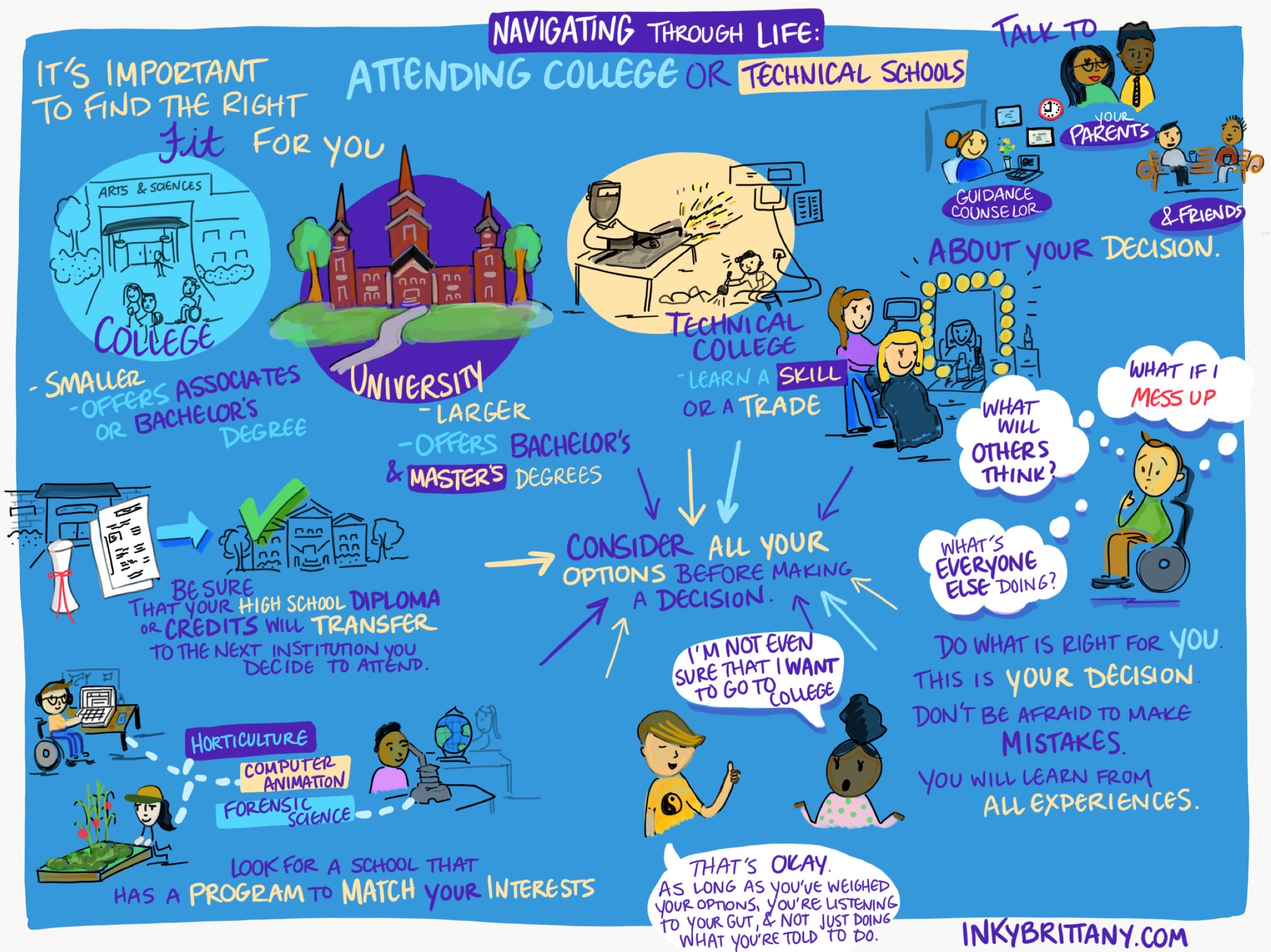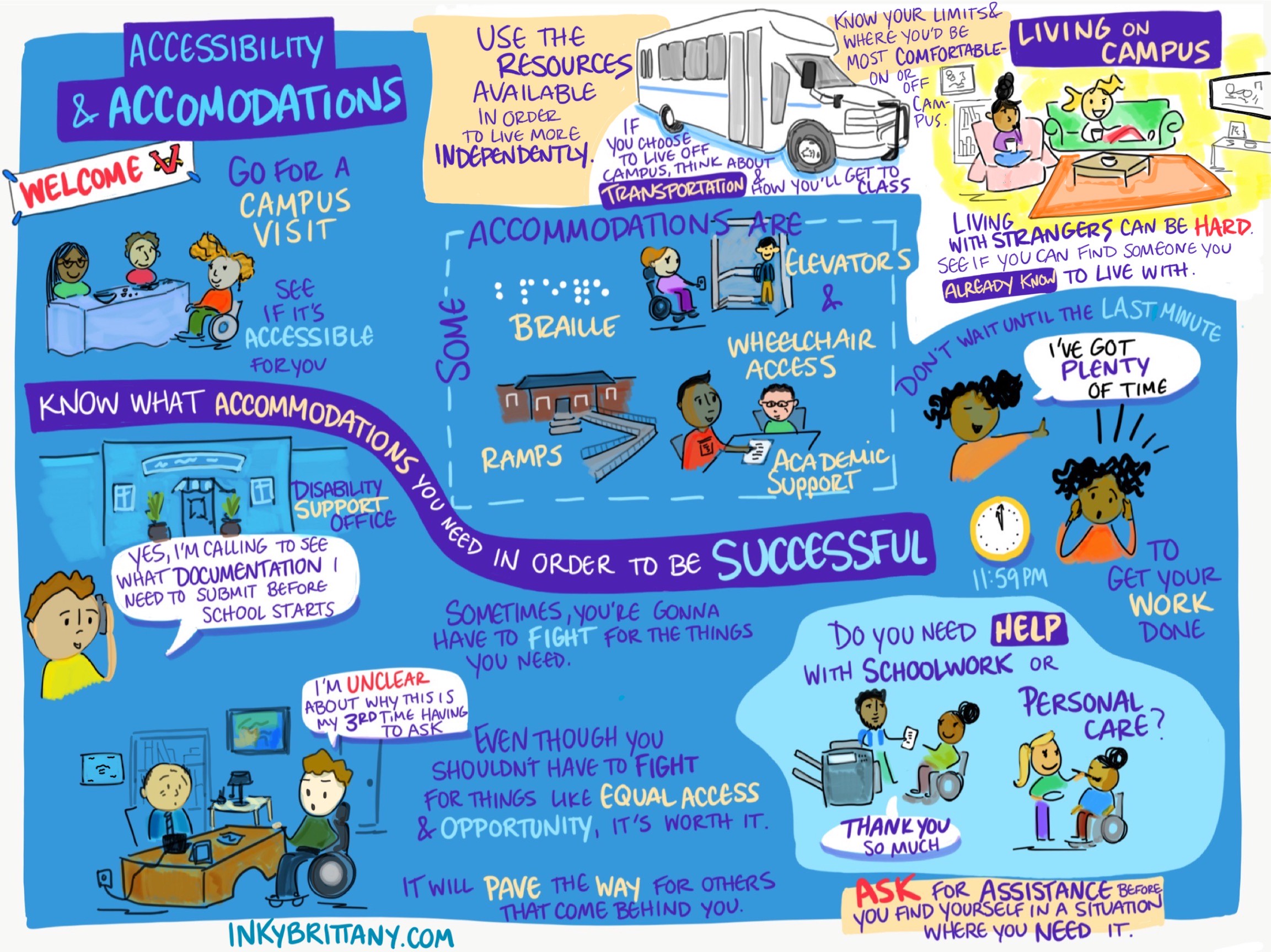College
There are a number of options to continue your education and training after high school. Post-secondary education and training can provide you with knowledge, experiences, and networks to find jobs and pursue your goals.


This image description is for the infographic “Navigating Through Life: Attending College or Technical Schools.” The infographic will give you information about how to navigate college or technical school as a person with disabilities. The infographic has two parts. The first part covers options regarding employment and education. The second part is about accessibility and accommodations in school. Brittany designed the graphic. You can find her at https://www.inkybrittany.com/.
The background color is blue. The text colors are different shades of yellow, blue, purple, and white. The information is scattered across the page in no particular order. From the top left, the text reads:
It’s important to find the right fit for you.
College:
- Smaller
- Offers associate’s or bachelor’s degree
University:
- Larger
- Offers bachelor’s and master’s degrees
Technical College:
- Learn a skill or a trade
[Pictures show a college, a university, and two examples of skills you learn at a technical college: cutting hair and welding.]
Be sure that your high school diploma or credits will transfer to the next institution you decide to attend.
Look for a school that has a program to match your interests.
- Computer animation
- Horticulture
- Forensic science
[Pictures show a boy in a wheelchair working at his computer, a girl kneeling to work on her garden, and a boy looking through a microscope.]
Consider all your options before making a decision.
[A picture shows two friends talking to each other. One says “I’m not even sure that I want to go to college.” The other says “That’s okay, as long as you’ve weighed your options, you’re listening to your gut, and not just doing what you’re told to do.”]
Do what is right for you. This is your decision. Don’t be afraid to make mistakes. You will learn from all experiences.
[A picture shows a person in a wheelchair thinking: “What if I mess up? What will others think? What’s everyone else doing?]
Talk to your guidance counselor, parents, and friends about your decision.
[Pictures show a guidance counselor, a set of parents, and some friends.]
This is part 2 of the infographic. It gives tips for accessibility and accommodations at school.
[A ribbon runs across most of the infographic. It says “Know what accommodations you need in order to be successful.”]
Go for a campus visit. See if it’s accessible for you.
[A picture shows a girl in a wheelchair rolling up to the campus visit welcome table.]
Some accommodations are:
- Braille
- Ramps
- Elevator and wheelchair access
- Academic support
[Pictures show braille, a building with a ramp, some people using an elevator, and someone helping a student with an assignment.
Sometimes you’re gonna have to fight for the things you need. Even though you shouldn’t have to fight for things like equal access and opportunity, it’s worth it. It will pave the way for others that come behind you.
[A picture shows a campus disability support office. It also shows a student calling the disability support office. The person says “Yes, I’m calling to see what documentation I need to submit before school starts.” Another picture shows a student in a wheelchair talking with a school administrator. The student says, “I’m unclear about why this is my 3rd time having to ask.”]
Use the resources available in order to live more independently. If you choose to live off-campus, think how you’ll get to class. Know your limits and where you will be most comfortable, on or off-campus.
[A picture shows a small bus with a lift.]
Living on campus: living with strangers can be hard. See if you can find someone you already know to live with.
[A picture shows a dorm room with two students inside.]
Don’t wait until the last minute to get work done.
[A picture shows a confident girl saying “I’ve got plenty of time.” The picture shows the same girl looking panicked later on because she does not have enough time.]
Do you need HELP with schoolwork or personal care? Ask for assistance before you find yourself in a situation where you need it,
[A picture shows a man handing a paper from the printer to a student in a wheelchair. Another picture shows someone helping a student to eat.]
Describing these pictures isn't necessary because the things they represent have already been listed, but I'm putting the description in just in case you want to use it anyway.